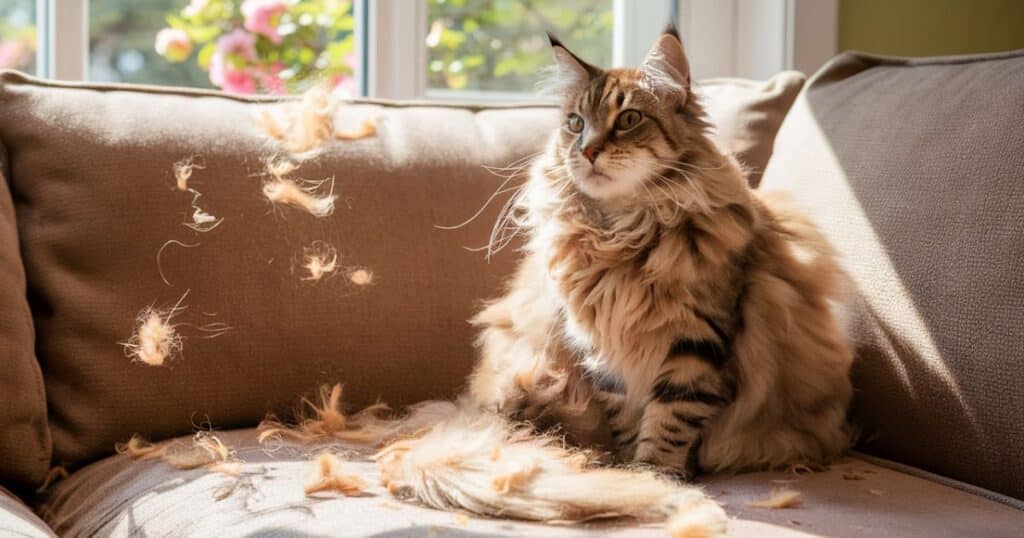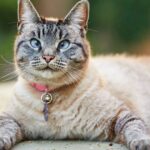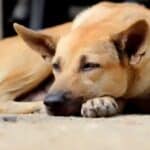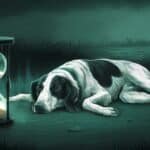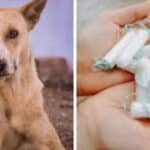As majestic as the rugged landscape of their native state, Maine Coon cats are truly a breed apart. With their striking semi-long fur, gentle personalities, and impressive sizes, it’s no wonder they’ve captured the hearts of cat lovers worldwide. However, one question often looms large for prospective owners: Do Maine Coon cats shed?
The simple answer is yes, Maine Coons do shed, and their luxurious double coats mean they shed quite a bit more than some other breeds. But don’t let that deter you just yet! With the right knowledge and care, managing a Maine Coon’s shedding can be a breeze, ensuring you can enjoy all the love and companionship these remarkable felines have to offer without being overwhelmed by excess fur.
In this comprehensive guide, we’ll delve deep into the world of Maine Coon shedding patterns, exploring the reasons behind it, factors that influence it, and most importantly, effective strategies to keep it under control. So, grab a brush (you’ll need it!) and let’s dive in!
What is a Maine Coon?
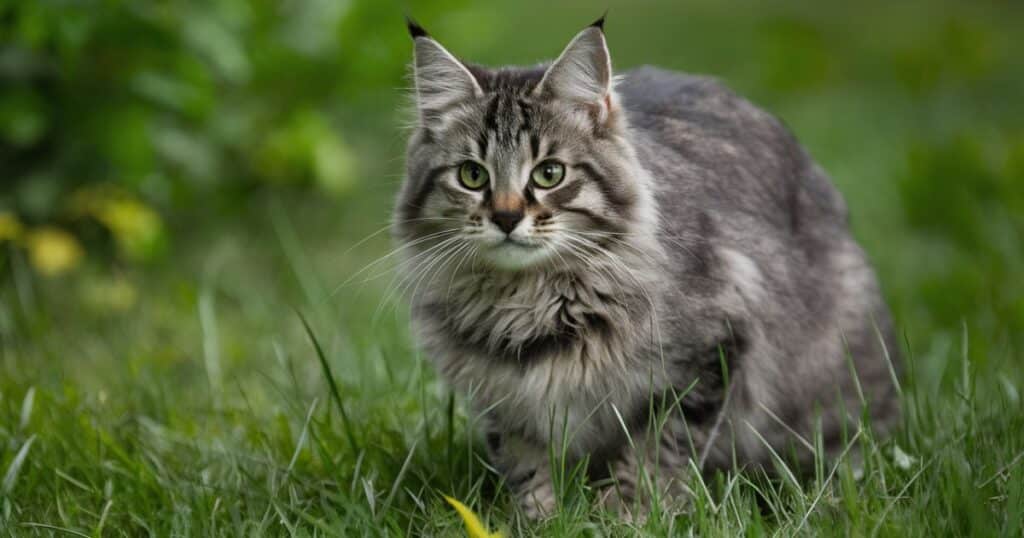
Before we tackle the specifics of Maine Coon shedding, it’s essential to understand the breed itself. Originating from the rugged shores of Maine, these cats are renowned for their large size, semi-long, shaggy coats, and gentle, affectionate personalities.
Maine Coons are often referred to as the “gentle giants” of the cat world, with males typically weighing between 13 and 18 pounds, and females ranging from 8 to 12 pounds. Their distinctive features include a rectangular body shape, a long, bushy tail, and a uniquely rectangular muzzle.
But it’s their luxurious double coat that truly sets them apart. This dense undercoat and longer, water-resistant outer coat not only contribute to their striking appearance but also serve a practical purpose – insulation against the harsh New England winters.
With their friendly, laid-back demeanors and minimal grooming requirements, Maine Coons have become increasingly popular pets, beloved for their intelligence, loyalty, and affectionate nature. However, their beautiful coats also come with a caveat – increased shedding.
ALSO READ: How Much Does A Maine Coon Cat Cost In 2024?
Understanding Shedding in Maine Coons
Do Maine Coon Cats Shed?
Absolutely! Maine Coons are known for their heavy shedding, especially during certain times of the year. This is a natural process for these felines, and it’s essential to understand the reasons behind it.
All cats shed to some degree, as it’s a healthy way for them to renew their fur and maintain a healthy coat. However, Maine Coons, with their thick double coats, tend to shed more than many other breeds. Their dense undercoat sheds continuously throughout the year, while their outer coat follows a more seasonal pattern.
Why Do Cats Shed Hair?
Shedding is a natural and necessary process for cats, and there are several reasons why it occurs:
- Seasonal Changes: As the seasons change, cats’ coats adapt accordingly. They shed more heavily in the spring to get rid of their thick winter undercoat, and again in the fall to prepare for the colder months ahead.
- Hormonal Fluctuations: Hormonal changes, such as those associated with heat cycles or neutering, can also trigger increased shedding in cats.
- Health and Nutrition: A cat’s diet and overall health can significantly impact their shedding patterns. Nutritional deficiencies or underlying health issues can lead to excessive shedding or poor coat quality.
- Stress and Anxiety: Just like humans, cats can experience increased shedding due to stress or anxiety, which can be caused by changes in their environment, routine, or living situation.
- Age: As cats age, their shedding patterns may change, with some older cats shedding more or less than they did in their prime.
While shedding is natural and necessary, excessive shedding can be a sign of an underlying issue that may require veterinary attention or adjustments to your cat’s diet, grooming routine, or living environment.
How Often Do Maine Coon Cats Shed?
Maine Coons are known for their heavy shedding, especially during certain times of the year. Their shedding patterns are influenced by both seasonal changes and their double coat structure.
Typically, Maine Coons shed heavily twice a year:
- Spring (March-May): As the weather warms up, Maine Coons shed their thick winter undercoat to prepare for the summer months. During this time, you may notice an abundance of loose fur around your home and on your furniture.
- Fall (September-November): In preparation for the colder months, Maine Coons begin shedding their summer coat and growing a thicker, denser undercoat for insulation. This shedding season can be just as intense as the spring shed.
However, it’s important to note that Maine Coons also shed continuously throughout the year, albeit to a lesser degree than during the major shedding seasons. Their dense undercoat is constantly renewing itself, resulting in a steady stream of loose hair.
Do Maine Coon Cats Shed More Than Other Cats?
Yes, Maine Coons are known for shedding more than many other cat breeds. This is primarily due to their unique double coat structure, which consists of a dense, insulating undercoat and a longer, water-resistant outer coat.
While all cats shed to some degree, Maine Coons’ thick coats and heavy shedding seasons mean that they tend to produce more loose fur than shorthaired or single-coated breeds. This can be particularly noticeable during the spring and fall shedding seasons, when clumps of loose hair may seem to accumulate everywhere.
However, it’s important to remember that every cat is an individual, and shedding levels can vary based on factors such as age, health, and living environment. Some Maine Coons may shed more or less than others, but their breed’s double coat generally means they’ll shed more than their shorthaired counterparts.
Understanding the Maine Coon Cat Coat
To fully grasp the shedding patterns of Maine Coons, it’s essential to understand the unique structure and characteristics of their coats.
Maine Coons are known for their luxurious double coats, which consist of two distinct layers:
- Undercoat: This dense, insulating layer is made up of short, downy fur that helps protect the cat from cold temperatures and moisture. It’s this layer that sheds continuously throughout the year, contributing to the constant presence of loose hair.
- Outer Coat: The longer, water-resistant guard hairs of the outer coat help repel moisture and protect the undercoat. This layer follows a more seasonal shedding pattern, with heavier shedding occurring in the spring and fall.
The combination of these two layers creates a thick, lush coat that not only contributes to the Maine Coon’s distinctive appearance but also serves a functional purpose – insulation against the harsh New England winters.
However, this double coat also means that Maine Coons shed more than many other cat breeds. During the major shedding seasons, both the undercoat and outer coat shed heavily, resulting in an abundance of loose fur around the home.
Shedding Seasons and Intensity
As we’ve discussed, Maine Coons experience two major shedding seasons each year, corresponding to the changing seasons. However, it’s important to understand the intensity and duration of these shedding periods, as well as the factors that can contribute to increased or decreased shedding.
Spring Shedding (March-May): As the weather begins to warm up, Maine Coons shed their thick winter undercoat to prepare for the summer months. This shedding season is typically the most intense, with large clumps of loose fur accumulating around the home and on furniture. The shedding may last for several weeks or even months, depending on the individual cat and the rate at which the old coat is replaced with a lighter summer coat.
Fall Shedding (September-November): In preparation for the colder months ahead, Maine Coons begin shedding their summer coat and growing a thicker, denser undercoat for insulation. While not quite as intense as the spring shed, this shedding:
Maine Coon Shedding Pattern Explained
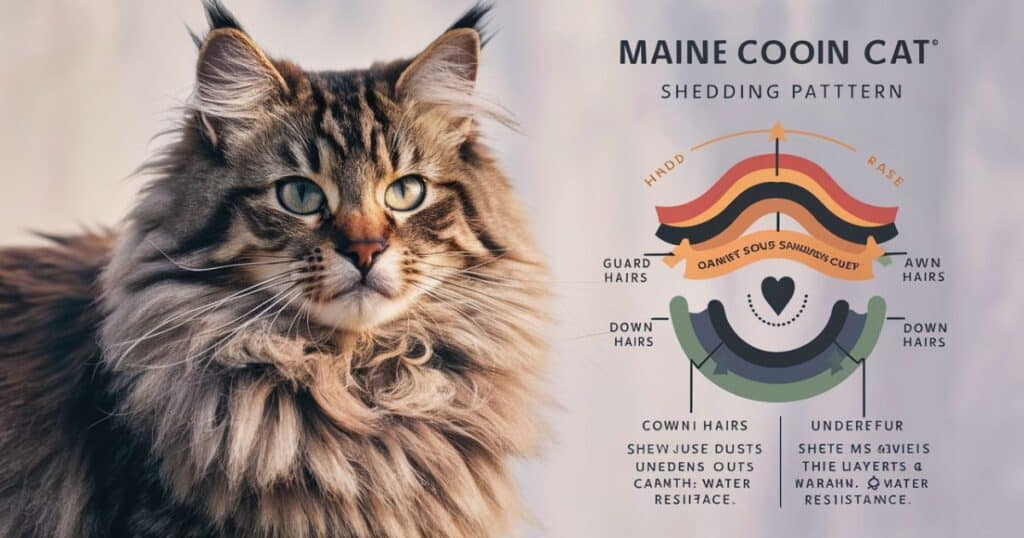
To better manage and control shedding, it’s helpful to understand the typical shedding pattern of Maine Coon cats. As we’ve discussed, their double coat structure means they shed throughout the year, with more intense shedding periods during seasonal changes.
Year-Round Shedding: Maine Coons’ dense undercoat sheds continuously, resulting in a steady stream of loose hair year-round. This constant shedding helps regulate their body temperature and maintain a healthy coat.
Spring Shed (March-May): As the weather warms up, Maine Coons shed heavily to remove their thick winter undercoat. This shedding season is often the most intense, with large clumps of fur accumulating around your home.
Summer Coat (June-August): After the heavy spring shed, Maine Coons sport a lighter summer coat, with minimal shedding during these warmer months.
Fall Shed (September-November): In preparation for winter, Maine Coons begin shedding their summer coat and growing a thicker, denser undercoat. This shedding season can rival the intensity of the spring shed.
Winter Coat (December-February): Once their heavy winter coat is in place, shedding decreases, but the dense undercoat still sheds continuously for insulation and temperature regulation.
Understanding this natural shedding cycle can help you anticipate and prepare for the heavier shedding periods, ensuring you have the right grooming tools and strategies in place to manage the excess fur effectively.
Factors Affecting a Maine Coon Cat’s Shedding
While Maine Coons are known for their heavy shedding, the amount and intensity of shedding can vary from one individual to another. Several factors can influence a Maine Coon’s shedding patterns:
Poor Diet
A high-quality diet rich in essential nutrients is crucial for maintaining a healthy coat and minimizing excessive shedding. A diet lacking in essential fatty acids, proteins, or vitamins can lead to poor coat condition, increased shedding, and even skin issues.
Health Conditions
Certain underlying health issues, such as hormonal imbalances, allergies, or skin conditions, can contribute to abnormal shedding patterns. If you notice sudden or excessive shedding, it’s essential to consult with your veterinarian to rule out any potential health problems.
Improper Hygiene
Regular grooming is essential for Maine Coons to remove loose hair and distribute natural oils throughout their coats. Failure to groom regularly can lead to matting, tangles, and increased shedding as the loose hair accumulates.
Stress and Anxiety
Just like humans, cats can experience stress and anxiety due to changes in their environment, routine, or living situation. Stress can cause increased shedding, so it’s essential to identify and address any potential sources of stress for your Maine Coon.
Heat and Humidity
High temperatures and humidity can also impact a Maine Coon’s shedding patterns. In warmer months, they may shed more frequently to regulate their body temperature and maintain a lighter coat.
By understanding these factors, you can take proactive steps to minimize excessive shedding and maintain a healthy, lush coat for your Maine Coon companion.
Excessive Shedding in Maine Coons – Did You Turn the Heat Up?
While Maine Coons are known for their heavy shedding, excessive shedding outside of the normal seasonal patterns can sometimes be a sign of an underlying issue. One potential culprit? Indoor temperatures.
Maine Coons are well-adapted to cope with cold temperatures thanks to their thick, insulating double coats. However, when indoor temperatures are too warm, their bodies may interpret this as a signal to shed more heavily to regulate their body temperature.
If you’ve noticed your Maine Coon shedding excessively, especially during the cooler months, it may be worthwhile to check your thermostat settings. Keeping indoor temperatures at a comfortable, moderate level can help prevent excessive shedding and maintain a healthy coat.
Additionally, it’s important to ensure your Maine Coon has access to cool, shaded areas during the warmer months, as overheating can also contribute to increased shedding.
Do Maine Coons Shed a Lot When They’re Sick?
Yes, illness or underlying health conditions can often lead to excessive shedding in Maine Coons. When a cat is unwell, their body may prioritize essential functions over maintaining a healthy coat, resulting in increased shedding or even patchy hair loss.
Some health issues that can contribute to excessive shedding in Maine Coons include:
- Skin conditions: Allergies, infections, or parasites can cause inflammation, itching, and hair loss.
- Hormonal imbalances: Thyroid disorders or other hormonal imbalances can disrupt the normal shedding cycle.
- Nutritional deficiencies: Lack of essential nutrients, such as proteins, fatty acids, or vitamins, can lead to poor coat quality and increased shedding.
- Stress and anxiety: Chronic stress can weaken the immune system and disrupt normal bodily functions, including coat maintenance.
- Aging: As Maine Coons age, their shedding patterns may change, and underlying health issues become more common, contributing to increased shedding.
If you notice sudden or excessive shedding accompanied by other symptoms like lethargy, loss of appetite, or skin irritation, it’s essential to consult with your veterinarian. Addressing any underlying health issues can help restore your Maine Coon’s coat to its former glory.
Is Stress Causing Your Kitty to Shed?
While shedding is a natural process for Maine Coons, excessive shedding can sometimes be a sign of stress or anxiety. Just like humans, cats can experience stress due to changes in their environment, routine, or living situation, and this stress can manifest in various ways, including increased shedding.
Some common sources of stress for Maine Coons can include:
- Environmental changes: Moving to a new home, renovations, or the introduction of new pets or family members can be stressful for cats.
- Lack of routine: Maine Coons thrive on routine, and disruptions to their daily schedules can cause anxiety and stress.
- Lack of enrichment: Without proper mental and physical stimulation, Maine Coons can become bored and stressed.
- Conflicts with other pets: Disputes or territorial issues with other pets in the household can be a significant source of stress.
- Health issues: Underlying health problems, such as pain or illness, can contribute to increased stress levels.
If you suspect stress is the culprit behind your Maine Coon’s excessive shedding, it’s essential to identify and address the root cause. Providing a stable, enriched environment, maintaining consistent routines, and ensuring your cat has plenty of safe spaces to retreat can help alleviate stress and minimize excessive shedding.
In some cases, calming supplements or pheromone diffusers may also help reduce stress-related shedding, but it’s always best to consult with your veterinarian before introducing any new products or treatments.
Does Your Maine Coon Shed Because of Poor Nutrition?
A well-balanced, high-quality diet is essential for maintaining a healthy coat and minimizing excessive shedding in Maine Coons. Poor nutrition can lead to a variety of coat issues, including increased shedding, dull or brittle fur, and even bald patches.
Maine Coons require a diet rich in essential nutrients, such as proteins, fats, vitamins, and minerals, to support healthy skin and coat growth. Deficiencies in these nutrients can disrupt the normal hair growth cycle, leading to excessive shedding and poor coat condition.
Some key nutrients that play a crucial role in maintaining a healthy coat include:
- Protein: Necessary for hair growth and strength, a lack of protein can lead to brittle, dull fur and increased shedding.
- Omega fatty acids: Essential for maintaining healthy skin and a lustrous coat, omega-3 and omega-6 fatty acids help reduce shedding and promote a shiny, full coat.
- Vitamins A, B, and E: These vitamins support skin health, hair growth, and overall coat condition.
- Zinc and iron: Deficiencies in these minerals can contribute to excessive shedding, hair loss, and dull coats.
In addition to a balanced diet, ensuring your Maine Coon drinks plenty of water is also crucial, as dehydration can lead to dry, brittle fur and increased shedding.
ALSO READ: How Much Does A Sphynx Cat Cost In 2024?
How to Know If Cat Food Is Ruining Your Maine Coon’s Coat
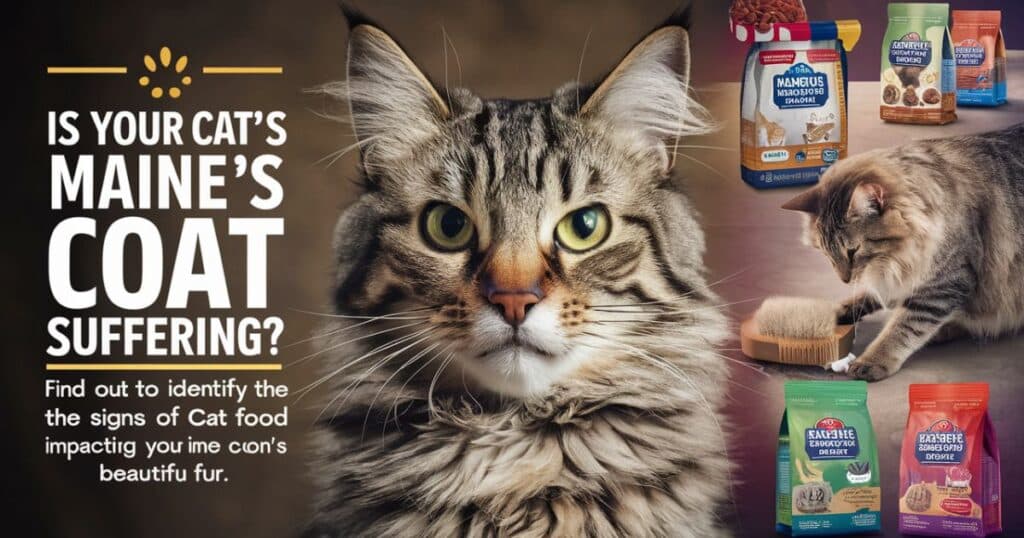
While a poor diet can contribute to excessive shedding and coat issues in Maine Coons, it can sometimes be challenging to determine if your cat’s food is the culprit. Here are some signs to watch out for that may indicate your Maine Coon’s diet is negatively impacting their coat health:
- Dull, Lackluster Coat: A healthy coat should be shiny and lustrous. If your Maine Coon’s fur appears dull or lacks its usual luster, it could be a sign of nutritional deficiencies.
- Excessive Shedding: While Maine Coons are known for their heavy shedding, excessive shedding outside of the normal seasonal patterns could be a result of poor nutrition.
- Brittle, Dry Fur: Dry, brittle fur that breaks or sheds easily can be a sign of a lack of essential fatty acids or other nutrients in your cat’s diet.
- Bald Patches or Thinning Coat: Severe nutritional deficiencies can lead to hair loss or thinning of the coat in certain areas.
- Skin Issues: Dry, flaky skin, hot spots, or other skin irritations can sometimes be linked to dietary imbalances or allergies.
- Poor Growth or Slow Shedding: If your Maine Coon’s coat seems to grow slowly or shed unevenly, it could be a sign of a nutritional issue.
If you notice any of these signs, it’s worth taking a closer look at your Maine Coon’s diet and consulting with your veterinarian or a pet nutritionist. They can help determine if your cat’s food is providing the necessary nutrients for a healthy coat and recommend any dietary changes or supplements that may be needed.
Remember, a high-quality, well-balanced diet is crucial for maintaining your Maine Coon’s overall health and promoting a lush, beautiful coat.
Managing and Reducing Shedding
While shedding is a natural and unavoidable process for Maine Coons, there are several strategies you can implement to help manage and reduce excessive shedding, ensuring a cleaner home and a happier, healthier cat.
How to Reduce Shedding in Your Maine Coon
Minimizing shedding in your Maine Coon requires a multi-pronged approach that focuses on grooming, nutrition, and other supportive measures.
Grooming
Regular grooming is essential for removing loose hair and distributing natural oils throughout your Maine Coon’s coat, minimizing excess shedding and promoting a healthy, lustrous appearance.
- Brushing: Use a well-designed slicker brush or deshedding tool to gently brush your Maine Coon at least once a week, paying extra attention to areas prone to matting or excessive shedding.
- Bathing: Occasional baths can help remove loose hair and keep your Maine Coon’s coat clean and healthy. However, be sure to use a cat-specific shampoo and avoid over-bathing, as it can strip the coat of its natural oils.
- Deshedding Tools: Special deshedding brushes, combs, or gloves can be particularly effective at removing loose undercoat hair during heavy shedding seasons.
Healthy Diet
As we’ve discussed, a high-quality, nutrient-rich diet is crucial for maintaining a healthy coat and minimizing excessive shedding. Ensure your Maine Coon’s food is formulated with the right balance of proteins, fats, vitamins, and minerals to support coat health.
Additionally, consider supplementing with omega fatty acids, such as fish oil, to promote a shiny, lustrous coat and reduce shedding.
Top Hygiene Tips to Control Shedding in Maine Coons
In addition to grooming and proper nutrition, maintaining good hygiene practices can also help minimize shedding and keep your Maine Coon’s coat in top condition.
- Regular Brushing: As mentioned earlier, regular brushing is essential for removing loose hair and preventing mats and tangles, which can lead to increased shedding.
- Bathing: While Maine Coons don’t require frequent bathing, an occasional bath with a gentle, cat-specific shampoo can help remove loose hair and keep their coat clean and healthy.
- Nail Trimming: Keeping your Maine Coon’s nails trimmed can prevent excessive shedding caused by scratching and pulling on loose hair.
- Vacuuming: Regularly vacuuming your home, especially in areas where your Maine Coon spends a lot of time, can help remove shed hair and prevent it from accumulating.
- Cleaning Bedding: Frequently washing your Maine Coon’s bedding can help remove any hair that has accumulated, keeping their sleeping area fresh and clean.
- Grooming Tools: Invest in high-quality grooming tools, such as deshedding brushes, combs, and gloves, to effectively remove loose hair and minimize shedding.
By maintaining good hygiene practices and incorporating regular grooming into your routine, you can help control shedding and keep your Maine Coon’s coat looking its best.
How to Stop Maine Coons from Shedding
While it’s impossible to completely stop a Maine Coon from shedding, as it’s a natural and necessary process for their health, there are several steps you can take to minimize excessive shedding and keep it under control:
- Establish a Consistent Grooming Routine: Regular brushing and deshedding are key to removing loose hair before it can be shed around your home. Aim to groom your Maine Coon at least once a week, or more frequently during heavy shedding seasons.
- Provide a High-Quality Diet: A well-balanced, nutrient-rich diet is essential for maintaining a healthy coat and minimizing excessive shedding. Ensure your Maine Coon’s food is formulated with the right balance of proteins, fats, vitamins, and minerals.
- Manage Stress and Anxiety: Stress and anxiety can contribute to increased shedding in cats. Identify and address any potential sources of stress in your Maine Coon’s environment, and provide plenty of enrichment and safe spaces for them to retreat.
- Address Underlying Health Issues: If excessive shedding persists despite proper grooming and nutrition, consult with your veterinarian to rule out any underlying health issues that may be contributing to the problem.
- Consider Supplements: In some cases, your veterinarian may recommend supplements, such as omega fatty acids or specific vitamins, to support coat health and minimize shedding.
- Maintain a Consistent Living Environment: Maine Coons thrive on routine and consistency. Avoid making significant changes to their living environment or daily schedule, as these can contribute to stress and increased shedding.
Remember, while you can’t entirely stop a Maine Coon from shedding, implementing these strategies can help you manage and minimize excessive shedding, ensuring a cleaner home and a happier, healthier cat.
Managing Shedding in the Home
No matter how diligent you are with grooming and coat maintenance, some shedding from your Maine Coon is inevitable. To keep your home fur-free and minimize the impact of shedding, consider the following tips:
- Vacuum Regularly: Invest in a high-quality vacuum cleaner with strong suction and attachments designed for pet hair. Regular vacuuming, especially in areas where your Maine Coon spends most of their time, can help remove loose hair from carpets, furniture, and other surfaces.
- Use Lint Rollers: Keep lint rollers or sticky tape handy for quickly removing pet hair from clothing, upholstery, and other fabrics.
- Groom Your Maine Coon Outside: When possible, brush or deshed your Maine Coon outdoors or in a well-ventilated area to prevent loose hair from accumulating inside your home.
- Use Pet Hair Remover Tools: Special tools, such as rubber brushes or lint remover stones, can be effective at removing pet hair from furniture and other surfaces.
- Wash Bedding Frequently: Regularly wash your Maine Coon’s bedding and any blankets or throws they frequently use to prevent hair buildup.
- Install Air Purifiers: Air purifiers with HEPA filters can help capture airborne pet hair and dander, improving indoor air quality and reducing allergens.
- Groom Before Guests Arrive: If you’re expecting visitors, give your Maine Coon a thorough brushing or deshedding session before they arrive to minimize loose hair in your home.
- Consider Furniture Covers: Removable furniture covers or slipcovers can protect your upholstery from pet hair and make cleaning easier.
By implementing these strategies and staying on top of regular grooming and cleaning, you can effectively manage shedding in your home and enjoy a cleaner, more comfortable living environment with your beloved Maine Coon companion.
Dealing with Seasonal Shedding
While Maine Coons shed continuously throughout the year, they experience two major shedding seasons – spring and fall – when they shed more heavily to prepare for the changing seasons. During these periods, you may notice an abundance of loose hair around your home and on your furniture, even with regular grooming.
To effectively manage seasonal shedding, it’s essential to adjust your grooming routine and take additional measures to keep shedding under control:
- Increase Grooming Frequency: During heavy shedding seasons, you may need to brush or deshed your Maine Coon more frequently, potentially daily or every other day, to keep up with the increased loose hair.
- Use Specialized Deshedding Tools: Invest in high-quality deshedding tools, such as deshedding brushes, combs, or rakes, to effectively remove the loose undercoat hair during these seasons.
- Bathe Your Maine Coon: An occasional bath with a gentle, cat-specific shampoo can help remove loose hair and keep their coat clean and healthy during heavy shedding periods.
- Increase Vacuuming and Cleaning: Step up your vacuuming and cleaning routine to stay on top of the excess hair around your home during these seasons.
- Consider Supplements: In consultation with your veterinarian, you may want to introduce supplements, such as omega fatty acids or specific vitamins, to support coat health and minimize excessive shedding.
- Provide Enrichment: Seasonal changes and increased shedding can be stressful for some cats. Ensure your Maine Coon has plenty of enrichment activities and safe spaces to retreat to during these times.
By adjusting your grooming routine and implementing additional measures to manage shedding, you can help your Maine Coon through these heavy shedding seasons while keeping your home fur-free and your cat’s coat in top condition.
Addressing Concerns About Shedding
While shedding is a natural and unavoidable process for Maine Coons, it’s understandable that excessive shedding can be a concern for some owners. Here are some common concerns about shedding and how to address them:
Concern: “My Maine Coon sheds too much!” It’s essential to remember that Maine Coons are known for their heavy shedding, particularly during seasonal changes. However, if the shedding seems excessive or constant, it could be a sign of an underlying issue, such as poor nutrition, stress, or a health condition. Consult with your veterinarian to rule out any potential problems and adjust your grooming routine and diet accordingly.
Concern: “The shedding is making my allergies worse.” Maine Coon fur can trigger allergies in some individuals, and excessive shedding can exacerbate these issues. To minimize allergens, prioritize regular grooming, vacuuming, and cleaning, and consider using air purifiers with HEPA filters. Additionally, consult with your healthcare provider about managing your allergy symptoms.
Concern: “I can’t keep up with the shedding!” Shedding can feel overwhelming, especially during heavy seasons. Invest in high-quality grooming tools and consider enlisting the help of a professional groomer during peak shedding periods. Additionally, adjust your cleaning routine and use pet hair removal tools to keep your home fur-free.
Additional Care Tips
In addition to managing shedding, proper grooming and care are essential for maintaining your Maine Coon’s overall health and well-being. Here are some additional tips to keep in mind:
How Often Should You Give a Maine Coon a Bath?
While Maine Coons are known for their luxurious coats, they don’t require frequent bathing. In fact, over-bathing can strip their fur of natural oils, leading to dryness and increased shedding.
As a general guideline, most Maine Coons only need a bath every 2-3 months or as needed when they become particularly dirty or greasy. However, some individual cats may require more or less frequent bathing depending on their activity levels and coat condition.
Take Baby Steps
If your Maine Coon is not accustomed to bathing, it’s important to take a gradual approach to introduce them to the process. Start by letting them explore the bathroom and get comfortable with the sights and sounds of running water. You can also try giving them a few treats in the bathtub to create positive associations.
Glove Up Before Bathtime
Maine Coons have a dense, water-resistant coat that can be challenging to lather and rinse thoroughly. Consider using grooming gloves or a soft brush to work the shampoo deep into their coat and ensure a thorough cleaning.
Conclusion
Shedding is a natural and unavoidable process for Maine Coon cats, thanks to their luxurious double coats and adaptation to changing seasons. While their heavy shedding can be a challenge for owners, it’s important to remember that it’s a healthy and necessary part of their coat maintenance.
By understanding the reasons behind shedding, recognizing the factors that can influence it, and implementing effective grooming and management strategies, you can minimize excessive shedding and enjoy a cleaner home while keeping your Maine Coon’s coat in top condition.
From establishing a consistent grooming routine and providing a high-quality diet to addressing any underlying health issues or stress factors, there are numerous ways to manage shedding and ensure your Maine Coon remains happy, healthy, and looking their best.
Remember, shedding is a small price to pay for the joy and companionship these gentle giants bring into our lives. Embrace their unique coats and take pride in the time and effort you invest in caring for your feline friend – they’ll certainly appreciate it, even if they can’t express it in words.
So, while shedding may be an ongoing battle, it’s one worth fighting for the privilege of sharing your life with these remarkable cats. Embrace the beauty of their coats, and enjoy the journey of managing their shedding – it’s all part of the Maine Coon experience.
ALSO READ THIS POST: What Vaccines Do Cats Need To Be Boarded?

Davin Connor is an experienced author with 3 years in pets writing. Known for concise, informative content, he shares expertise on pet care, behavior, and health through his engaging articles.
